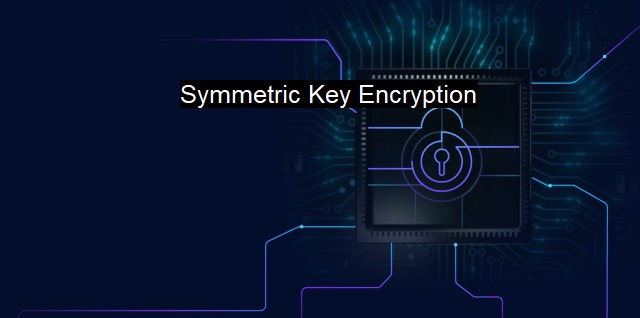What is Symmetric Key Encryption?
Exploring the Basics and Evolution of Symmetric Key Encryption: A Tried-and-True Cybersecurity Technique for Securing Data Transmission and Storage
Symmetric Key Encryption, also known as secret key encryption, is a critical cornerstone of cybersecurity. Encompassing a vast array of different cryptographic systems, symmetric encryption is a critical component in the maintenance of system integrity and protection against cyber threats.Symmetric Key Encryption involves the use of a single, identical cryptographic key for both encrypting and decrypting data. The principle is simple: if you want to send another party a message, you cipher this information with your secret key - which could be a string of numbers or letters, or a binary sequence. The recipient then uses the same key to decipher the cipher, rendering the initially unreadable information discernable. This methodology is based on the premise of shared secrets - where two or more parties have access to the same encrypting and decrypting key.
The strength of symmetric encryption lies in its simplicity and efficiency. Since they use one key instead of two (as in asymmetric encryption), symmetric encrypting algorithms can be substantially faster and more efficient even when processing large amounts of data. This makes symmetric encryption suitable for systems or applications that have to handle large data transfers constantly, securely, and quickly.
Symmetric Key Encryption can be subdivided into two broad categories: stream ciphers and block ciphers. A stream cipher encrypts one bit of data at a time in a continuous stream, working best with data streams of unknown length. On the other hand, a block cipher encrypts a whole block of data at once, typically working with known volumes of data in multiples of a fixed size, something physically defined by the algorithm.
Symmetric encryption has one major drawback, which contributes to its diminished effectiveness in some contexts. The distribution of keys between users can pose an alarming security risk. Anyone who manages to gain access to a key can easily decrypt encrypted information, posing significant security concerns. Therefore, special secure channels must be put in place to distribute keys safely.
Still, Symmetric Key Encryption is foundational to the field of cybersecurity and plays a crucial role in several mechanisms pertaining to antivirus software. Antivirus applications frequently use this technique to encrypt sensitive information like databases for malicious software definitions, user login information or registration keys, thereby securing this information from potential cyber threats.
For instance, if an antivirus has detected a potential threat, sensitive data must be sent from the client device to the antivirus service provider for verification and risk assessment. This outgoing communication must be securely encrypted to ensure that malevolent agents do not intercept and exploit its content. This is where Symmetric Key Encryption becomes a trusted asset owing to its encryption speed and efficiency.
Today's robust cybersecurity architectures make extensive use of Symmetric Key Encryption for activities such as creating secure sockets layer sessions (SSL sessions), file and folder encryption, password validation, and even web browsing.
In the end, Symmetric Key Encryption is a powerful cybersecurity tool offering rapid encryption, ease of implementation, and efficient computational performance, making it ideal for encrypting large data volumes. Its application in antivirus systems and a range of other cybersecurity contexts is testament to its prowess and continued relevance, despite evolving challenges in the contemporary cyber landscape and the emergence of other encryption methods. While the distribution of its decryption keys needs to be handled meticulously to avoid compromization, the overall merits of Symmetric Key Encryption make it an integral element of efficacious system protection and data security.

Symmetric Key Encryption FAQs
What is symmetric key encryption?
Symmetric key encryption is a type of encryption process that uses the same key to both encrypt and decrypt data. It is a common method used in cybersecurity to protect sensitive information.How does symmetric key encryption work?
In symmetric key encryption, the same secret key is used to both encrypt and decrypt data. This key is kept secret and shared only between the sender and the recipient of the encrypted data. The encryption algorithm transforms the plaintext data into a ciphertext using the secret key. Then, the decryption algorithm reverses the process to transform the ciphertext back into its original plaintext form.What are the advantages of symmetric key encryption?
Symmetric key encryption is a fast and efficient method for encrypting large volumes of data. Additionally, it is relatively easy to implement and can be used in a variety of applications, such as email encryption, file encryption, and database encryption.What are the risks associated with symmetric key encryption?
One of the main risks associated with symmetric key encryption is the vulnerability of the secret key. If the key falls into the wrong hands, all of the encrypted data can be easily decrypted. Additionally, symmetric key encryption does not provide authentication or non-repudiation, meaning that it cannot verify the identity of the sender or guarantee that the data has not been altered.| | A | | | B | | | C | | | D | | | E | | | F | | | G | | | H | | | I | | | J | | | K | | | L | | | M | |
| | N | | | O | | | P | | | Q | | | R | | | S | | | T | | | U | | | V | | | W | | | X | | | Y | | | Z | |
| | 1 | | | 2 | | | 3 | | | 4 | | | 7 | | | 8 | | |||||||